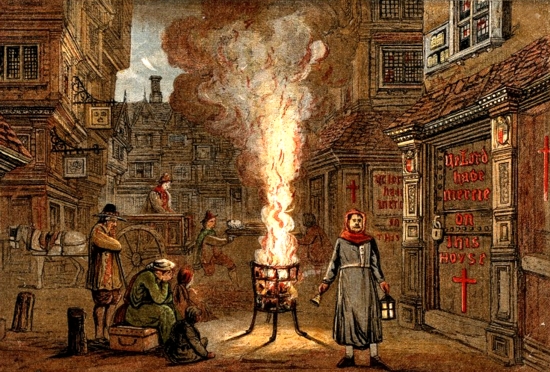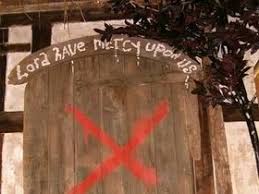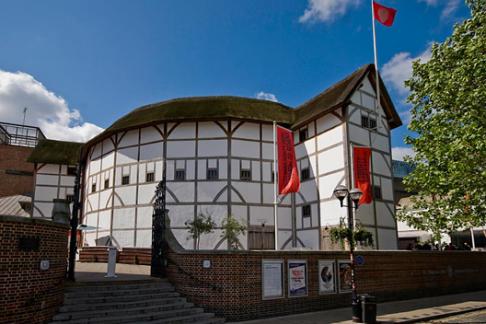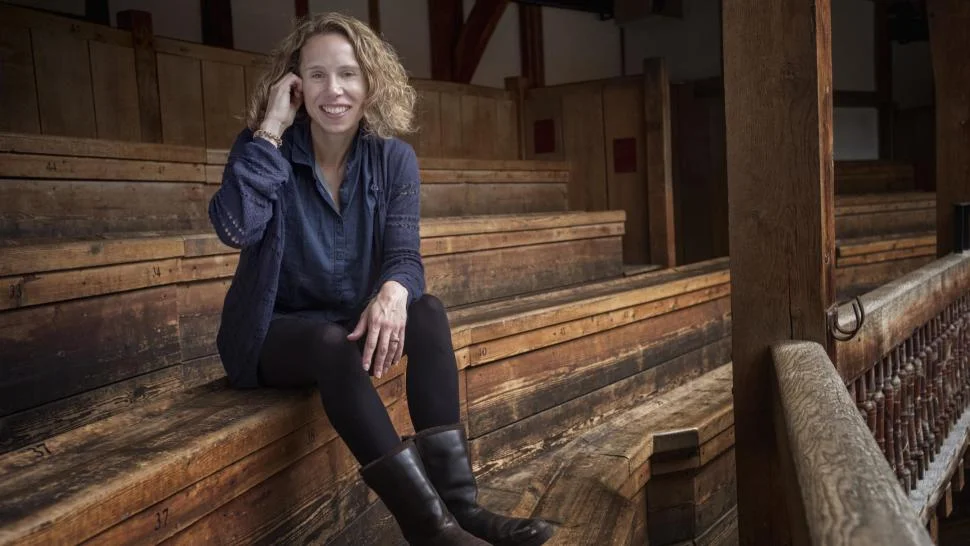In sinful Southwark, where we lay our scene…
There is a lot to celebrate at Shakespeare’s Globe right now. Monday was annual Shakespeare’s day, while Wednesday saw opening night of new artistic director Michelle Terry’s first major production at the theatre’s helm. She also happens to be performing. As the lead. It’s Hamlet.
Terry’s re-visioning of London’s most hallowed theatrical hall takes a leaf directly from Shakespeare’s book as a dramatist for the people. She’s committed to combatting elitism in the theatre, which she sees as the antithesis of what the Globe is all about. As a space it is deeply resonant with the historic trials and tribulations of inner city living, and has provided escape and wonder to those enclosed in its wooden walls. It therefore seems fitting to take a little journey into its story, and the dedicated and brave characters that have sustained it as a resource for looking at the world differently, from inside the Globe.
A word on the wordsmith…
Relatively little is known about Shakespeare, despite his being arguably the greatest writer ever to have lived. He was born in 1564 in Stratford-upon-Avon, his father was a glove maker before later becoming a senior member of the local council. The young Shakespeare was particularly gifted in Latin and rhetoric - undoubtedly skills that provided the grounding for his future as a playwright - and was educated at a local grammar school. He was married young to his bride Anne Hathaway and became a father aged 18.
It is thought to be these relatively humble origins that have made him such a primary target for conspiracy theories and forgery. Unlike the so-called ‘cult of genius’ that came after him with the romantic writers and poets of the 1700s, Though he amassed considerable wealth in his lifetime from his theatrical endeavors, Shakespeare was not educated at Oxford or Cambridge, or any university for that matter, and he was not a member of the aristocracy. As such, his monumental place history would have been quite unforeseen and his life largely undocumented, being that he was not attached to any prominent house or institution. This makes the mania that has grown up around him all the more remarkable, and for some, unbelievable.
The First Folio, printed 1623
Our relatively comprehensive inheritance of his work, if not his biography, is largely indebted to his devoted colleagues John Heminge and Henry Condell, members of Shakespeare’s company The King’s Men, who painstakingly collected and published almost all of his plays in a volume now known as the First Folio, published 7 years after the playwright’s death. It included 18 previously unpublished plays, among them Macbeth and As You Like It and it is incredible but not improbable to think that without the posthumous dedication of the pair we might never have had the complete works of Shakespeare as we know them today.
All the Globe is a stage
An enhanced 1612 etching of the Globe theatre.
In the early Elizabethan period, plays were staged in inns, college halls and private houses and it wasn’t until 1576 that the first purpose-built playhouse was constructed by the actor-manager James Burbage. Simply called the Theatre at Shoreditch, it stood - as the name suggests - in London’s East End. Shakespeare joined its resident troupe (later known as the Chamberlain’s and then the King’s Men) in the 1580s and the company thrived there for the best part of the next two decades. Burbage died in 1597, mired in a dispute over the theatre’s lease, a battle which was to continue for two years after his death. In the end the players, true to form, dramatically resolved to dismantle the entire theatre and carry the timber over the bridge to a plot of land they had leased in Southwark.
Impression of the Globe's interior
The Globe’s glorious inaugural season was in 1599, with Julius Caesar being one of the first plays performed. It is fascinating to think that some of Shakespeare's best loved plays would have been written specifically for The Globe, including Othello and King Lear. Its trap-door for example, known as ‘hell’, facilitated the staging of ghost scenes in Hamlet while the cloth canopy above the stage, which shielded it from the elements in the famously open air theatre, was known as ‘heaven’.
Pestilence did reign
One thing that we can say for certain about Shakespeare’s life is that it was pockmarked and punctuated by plague. The year he was born in Stratford-upon-Avon, the town lost a quarter of its population to plague, making it close to miraculous that the infant Shakespeare survived unscathed. Throughout his life, his career as a dramatist was profoundly affected by the disease, as large gatherings like those that would have surely amassed at his performances were necessarily prohibited to prevent the spread of infection.
In these plague scourged times, disease and death was never far from people’s minds - and there was considerable moral and social anxiety surrounding the ‘sinfully polluted suburbs’, particularly Southwark, which was the district where theatres, bear-pits and brothels plied their trades. Indeed, in the terrible plague spate of the summer of 1603, the first outbreak was documented to have occurred in Southwark, and crowded public spaces such as the Globe were among the first to close and the last to reopen in plague ravaged periods.
The 1603 outbreak was particularly devastating, London lost a fifth of its population over the course of the summer and the city was brought to a standstill, with weeds and grass sprouting in even the busiest thoroughfares. Bubonic plague was the most common form of plague to lay waste to London, and had been endemic since the 1400s - its effects were quite horrifying, causing the lymph nodes to blacken, expand and often burst, resulting in multiple organ failure. Quarantine measures were put in place, and houses wherein family members had contracted the plague were initially marked by a pole suspended above the doorway with hay hanging from it. Later this custom was replaced by oil painted signs that were more difficult to remove, with the words ‘Lord have mercy on us’ daubed alongside the now universally recognizable Red Cross. These looming red omens were a frightening sight for passers by, and when the theatre reopened many months later, the absence of many familiar faces - both in the audience and on-stage - would have been palpable. Interestingly, scholars have noted that though plague would surely have been the word on everyone’s lips, it is curiously absent from his writing and though the audience must have seen its effects all around them, they never saw it before them onstage. The closest reference to be found in any of his plays is surely in Romeo & Juliet, when crucially Friar Lawrence’s letter is unable to be delivered to Romeo as, according to the messenger’s account:
“...the searchers of the town,
Suspecting that we both were in a house
Where the infectious pestilence did reign,
Sealed up the doors and would not let us forth.”
-Act IV, Romeo & Juliet
The audience, hearing this, would have known its ominous meaning all too well, and a frisson of relief for the passing of the plague would have surely shuddered through the theatre.
The summer of 1613 scorched a little more ferociously following a fire that broke out during a performance of Henry VIII when a theatrical cannon used in the performance misfired and set the theatre’s thatched roof alight. Miraculously, no one was injured in the blaze, save one man who, it is said, had his burning trousers fittingly extinguished with a bottle of ale. Within a couple of hours the theatre was burned to the ground. Undaunted, the company wasted no time rebuilding The Globe, this time with a tiled roof, and it remained their home until 1642, when puritan reformations enforced the closure of all theatres. In 1644 the theatre's iconic structure was torn down to make way for housing.
Resurrecting the Globe
The American actor/director Sam Wanamaker first visited London in 1949 and after the visit, made it his mission to reinstate Shakespeare’s iconic theatre. Wanamaker’s first theatre job had been onstage in a Shakespearean play, a gig that was to change both his life and the lives of theatre-goers forever. It was an ambitious project many said was impossible, and one that would outlive Wanamaker himself; The Globe’s website describes his dedication:
“Twenty-one years later he founded what was to become the Shakespeare Globe Trust, dedicated to the reconstruction of the theatre and the creation of an education centre and permanent exhibition. After 23 tears spent tirelessly fundraising, advancing research in to the appearance of the original Globe and planning the reconstruction with the Trust’s architects Theo Crosby, Sam Wanamaker died in 1993, the site having being secured, the exhibition undercroft structurally complete and a few timber bays of the theatre in place. Three and a half years later the theatre was completed.”
Opened by the Queen in 1997, the officially titled 'Shakespeare’s Globe’ stands 230 meters from the site of the original and has been painstakingly constructed to facilitate the closest approximation possible to the authentic Elizabethan theatre. In terms of architectural guidelines, the team behind its reconstruction had to rely heavily on their imaginations - the only visual clues came from panoramas of London printed by John Norden and Wenceslaus Hollar, while the inside had to be deduced from written accounts of those that visited. When a minor archaeological investigation of the original Globe site took place - it was revealed to have been a 20-sided building with a diameter of 100 feet.
Wenceslaus Hollar's panorama of London
"Techniques used in the reconstruction of the theatre were painstakingly accurate. ‘Green’ oak was cut and fashioned according to 16th-century practice and assembled in two-dimensional bays on the Bankside site; oak laths and staves support lime plaster mixed according to a contemporary recipe and the walls are covered in a white lime wash. The roof is made of water reed thatch, based on samples found during the excavation.” - Shakespeare’s Globe
21st Century dismantlement
2017 saw the actor Michelle Terry take on the coveted role of artistic director at the Globe. With no directing experience, she was perhaps not the obvious choice, but her bravery and commitment to once again reforming the theatre, this time in a way that is fit for the future, is to be applauded.
Her vision is inspired by none other than Shakespeare himself, as she describes:
“[He] gives us no character descriptions but gives us the more to “hold the mirror up to nature”. I think this binary was of looking at gender, looking at the world, has reached a tipping point. We’re doing a gender-blind, race-blind, disability-blind production.”
Of course, gender fluidity is a prominent characteristic of Shakespeare’s writing and staging. Women were famously forbidden from appearing onstage in Elizabethan theatre, as it was thought to be a lewd and highly immoral occupation for them. Female roles were instead performed by boy actors whose voices had not yet broken, though at the time this would have occurred much later, on account of differences in diet and lifestyle - actors were for the most part between the ages of thirteen and nineteen. It is fascinating to think that in addition to writing his plays with the Globe’s staging structure in mind, Shakespeare would also have been writing to the prescribed gender structure of the day. Even when his characters were not disguising themselves as the opposite sex, one could be certain that the female parts were always to be played by males. His writing was somewhat liberated from moral concerns and was able to be more playful when it came to modesty and propriety, in a way that it perhaps could not have been had there been Elizabethan women on the stage.
Margaret Hughes, one of the earliest Shakespearean actresses
Following King Charles II’s ascent to the throne in 1660, theatres and playhouses were reopened, and for the first time women were permitted onstage. It was an adjustment that proved difficult for the dramatic community and their audiences, but most of all for the women themselves who had to deal with being discriminated against as anything from prostitutes to “titilating diversions” rather than serious actors. The sexual potency of seeing a woman onstage would have been palpable in the theatre, prologues were written specially to warn audiences that a real woman would be gracing the stage and it was the cause of much moral debate. Among the abuses these female actors endured were wealthy patrons paying a little extra for their tickets to watch them changing in the wings. Nevertheless, there were six or seven prominent names at the time that worked tirelessly to carve out a space for women in the all-male theatres, and became sought after celebrities of their time. Men continued to take on female roles and popular boy actors garnered their fair share of attention, often seen in full Shakespearean costume riding through the city in the carriages of wealthy female theatre fans.
Fast-forward 350-odd years and Michelle Terry has a lot on her plate co-ordinating her own inaugural season of gender-smashing, non-binary performances, first up are As You Like It and Hamlet, in which she also has the small task of playing the leading role. It is surely another historic moment in the colorful history of Britain’s beloved theatre, and proof once again that the wisdom of William Shakespeare appears today as relevant and captivating as ever.















